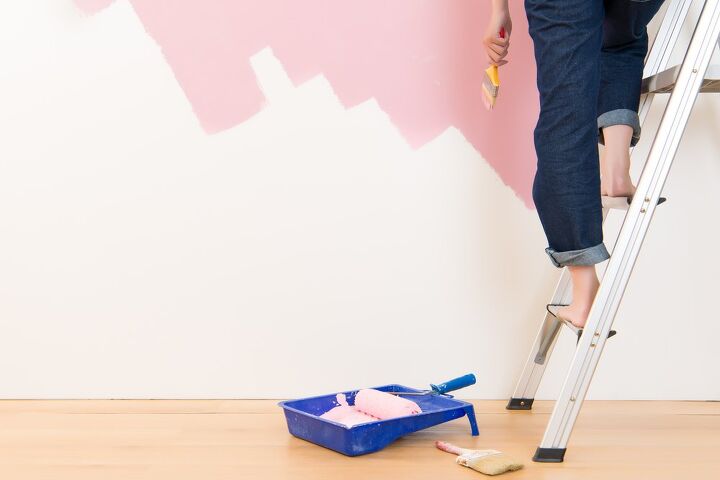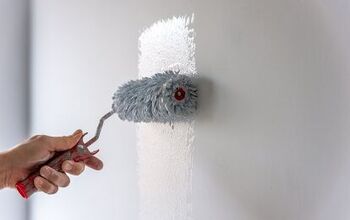Do You Paint Walls Or Trim First? (Find Out Now!)

A fresh coat of paint is one of the easiest and most affordable ways to drastically change your home’s interior. But just because it’s simple doesn’t mean you can dive right in without a plan. Proper prep work is vital to a professional-looking paint job and includes approaching things in the proper order. For example, do you paint walls or trim first?
There are advantages to painting the walls or the trim first. In most cases, painting the walls first makes the most sense. It’s common to use a roller to paint walls, which can lead to potential splatters on your trim. But, many pros swear it’s easier to tape off the trim than walls, so painting trim first works better.
Overall, whether you paint the walls or the trim first will depend on your specific situation and personal preference. Therefore, it’s best to know the upsides and drawbacks of both methods to decide which is the best for you.
In What Order Do You Paint The Interior Of A House?
The general rule of thumb when painting the interior of a house is to work from the top down. Therefore, you would start with the ceiling, then the walls, then baseboards, door frames, and trim.
The primary reason for this is that as you paint, you’ll likely drip paint to the surfaces below. So, if you’re working from top to bottom, you’ll end up covering up these drips and mistakes. You save yourself a step since you won’t have to go back and fix something you already painted.
When Should You Paint The Walls Before The Trim?
What comes first, the walls or the trim? In a way, it’s like the age-old question, what comes first, the chicken or the egg? However, many pros will tell you that painting the walls before the trim will save you a lot of time.
Here are several situations where painting the walls before the trim makes the most sense.
1. Paint Walls First Because Of Splatters
When you roll paint onto the walls, you’ll likely have a bit of paint splatter or drip onto the trim. If you paint the walls first, you won’t have to worry about it since you’ll be painting the trim next.
However, if you painted the trim first, you’d have splatters on your freshly painted woodwork. You’ll end up doing double work because you’ll need to go back and touch up something you already painted.
2. Painting Walls First Can Motivate You
If you’re not a huge fan of painting, doing the walls first can help motivate you. Seeing the new color on the walls delivers a sense of instant gratification. Your walls take up much more visual space in a room than the trim, so you’ll see more color faster.
Such a significant visual change can have a massive impact on a room. Plus, in some cases, it might be such a big change that you decide you don’t even need to paint the trim.
3. Nail Down The Wall Color First Before Painting The Trim
It’s always wise to try out some paint samples before painting your entire room. However, sometimes, you can get pretty far into your paint job before realizing the color isn’t what you wanted.
Ensure you get the exact color you want on the walls, then move on to the trim. This way, you can ensure you have the right color combination. Otherwise, you might change your mind about the wall color halfway through and need to change the trim color too.
When Should You Paint The Trim Before The Walls?
It’s essential to remember that when it comes to painting the walls or trim first, there’s no one correct answer. Just like painting the walls first makes sense, there are also times when painting the trim before the walls is a better option.
Here are times when you might want to tackle the trim painting before you move on to the walls.
1. Paint Trim First If You Are Great At Cutting In Paint Edges
Paint the trim first if you are skilled in cutting in paint edges. Some people have a knack for cutting around trim and windows, etc.
Many pros will skip taping off trim because they are so adept at cutting in edges that it saves them time. But, you need to have a steady hand and know your skill level. Otherwise, you can end up with a big mess on your hands and spend a lot of time on touch-ups and repainting.
2. Painting Trim Before Walls Could Be Easier
A lot of trim is three-dimensional, with grooves or details. In some cases, it might be smaller and more delicate.
It could be easier for you to simply paint the trim first. You can do so without a worry about paint getting on the walls since you’ll be painting those next. This might be the better way to go if you aren’t a meticulous painter.
Then, you’ll need to allow the trim to dry completely so you can tape it off before painting your walls. Many people feel taping off trim is much easier than taping off walls, especially if the wall has a lot of texture.
3. Paint Trim First When It’s New Construction
If you can, It’s ideal to paint your trim before installing it. This is the perfect solution if you’re remodeling or have a new construction home. You can paint all the trim, then install it over the finished walls. In this situation, you only need to touch up any nail holes from installation.
Tips For A Pro Paint Job
No matter if you paint the walls or the trim first, there are must-do tips when it comes to painting your home’s interior. If you want to end up with a professional looking paint job, keep these pointers in mind.
- Don’t skimp on your paint and tools. Purchase high-quality paint, primer, rollers, and brushes. You don’t want to end up with cheap paint that will chip and peel or brushes that leave behind bristles. Low-quality brushes and rollers will also deliver an uneven finish and cost you more time in the long run.
- Take time to prep surfaces before painting. Dust and wipe down the trim and walls. Let everything dry thoroughly before you apply paint.
- Be honest about your painting skills. If you don’t have a steady hand, taking the time to use FrogTape® will save you a lot of effort and time.
- Use a primer. A primer helps give you an even surface for your paint color and better coverage. It also can provide stain and mildew-blocking capabilities and save you money. Primer is cheaper than paint, so it’s preferable to having to do multiple coats of your paint.
- Let paint dry between coats. Even if you use a paint-and-primer in one, you should still expect to need at least two coats. Make sure the primer and paint dry completely in between coats. Otherwise, you’ll push and pull wet paint around and leave streaks and inconsistencies.
Summary
In many cases, painting the walls before the trim will make the most sense to avoid having to repaint because of splatters. It also delivers a sense of instant gratification, and you might even decide that you don’t need to change your trim color after all.
In general, painting from top to bottom is best as paint inevitably drips to surfaces below. Therefore, you would paint the ceiling, then the walls, then the trim.
But, if you have a steady hand and are adept at cutting in around edges, paint your trim first. Plus, since most walls have a texture, it’s usually easier to tape off the trim than the walls.
If you tend to be a little messier when you paint, tackling the trim first could be best. This way, you don’t have to worry about getting paint on the walls, then can simply use FrogTape® to tape off the trim.
Remember, there isn’t any right or wrong answer when it comes to painting the walls or trim first. The more you paint, you’ll discover what method works best for you and your skills.

Stacy Randall is a wife, mother, and freelance writer from NOLA that has always had a love for DIY projects, home organization, and making spaces beautiful. Together with her husband, she has been spending the last several years lovingly renovating her grandparent's former home, making it their own and learning a lot about life along the way.
More by Stacy Randall



























